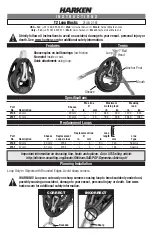
R E N
R E N
SR Q
R E N
Chapter 5—Operating Instructions
35
iv. E Applied or I Applied, according to selected mode.
Note: If the scan proceeds too fast for the bottom line of the display to be updated in real
time, the message "SCANNING" will be displayed on the bottom line.
5.2.5. INTERFACE Group
This area of the panel contains five indicators and a pushbutton. They provide useful information
when controlling the Model 273A from a remote computer. When the instrument is under
front-panel control, all five indicators should be extinguished and the LOCAL key will have no
function.
When controlling from a remote computer via the GPIB or RS-232C port, all five indicators and
the pushbutton are active, although SRQ, REMOTE, and the pushbutton apply to GPIB
communications only. A brief description of each follows.
1. TALK: This indicator lights when the Model 273A has output ready to send to the host
computer. It goes out when the Model 273A has finished sending this output. The TALK
indicator does NOT signal that the host computer has transmitted a TALK message. Rather it
indicates that the Model 273A has more output to dump before the command is completed.
2. LISTEN: This indicator lights when the Model 273A senses the first character of a command.
It remains lighted until the terminator is sensed. The LISTEN indicator does NOT signal that
the host computer has transmitted a LISTEN message. Rather it indicates that the Model
273A is expecting more input before the current command is fully defined.
3. REMOTE: This indicator lights when the Model 273A is under remote control via the GPIB
interface, that is,
is asserted and the Model 273A's LISTEN address has been applied.
As long as the REMOTE indicator is lighted, the Model 273A's front panel is "locked out."
Return from remote to local operation can be accomplished simply by pressing the adjacent
LOCAL key (only effective if the LOCAL LOCKOUT message hasn't been applied). Other
ways of returning to local include applying the GO TO LOCAL message, deasserting
, or
cycling the power. Note: LOCAL LOCKOUT and GO TO LOCAL are GPIB messages
defined by IEEE-488.
4. SRQ: This indicator lights when
is asserted, that is, when the Model 273A has initiated
a service request. (The use of SRQ and serial polling to control GPIB communications is
discussed in Subsection B.4 of Appendix B of the Model 273A Remote-Programming
Command Handbook.) It remains lighted until the controlling computer completes a serial
poll of the Model 273A or the power is cycled.
5. ERROR: This indicator lights if there was an error in the most recently executed command.
The nature of the error can be determined by evaluating the ERR command response.
6. (LOCAL): This key returns the Model 273A from GPIB control to front-panel control (See
Appendices A and B of the Model 273A Remote-Programming Command Handbook for a
discussion of GPIB Communications Considerations.) It is effective only if the GPIB LOCAL
LOCKOUT message has not been applied. Also, as long as
continues to be asserted,
applying the Model 273A's LISTEN address will immediately restore GPIB control. Note that
this key does not affect control of the Model 273A via the RS-232C Interface, which is
always active.
If the LOCAL key is pressed while executing a multiple remote command, an error will occur
because there will be a remote/local violation. The host computer can avoid this possibility
by sending LOCAL LOCKOUT (a GPIB message), which disables the effect of the LOCAL
key.
Summary of Contents for 273A
Page 1: ...0RGHO 3RWHQWLRVWDW DOYDQRVWDW 8VHU V 0DQXDO 8VHU V 0DQXDO 3ULQWHG LQ 86...
Page 6: ...vi Model 273A Potentiostat Galvanostat User s Manual...
Page 10: ...4 Model 273A Potentiostat Galvanostat User s Manual...
Page 23: ...Chapter 3 Characteristics 17 Fig 3 Model 273A Simplified Block Diagram...
Page 26: ...20 Model 273A Potentiostat Galvanostat User s Manual...
Page 66: ...60 Model 273A Potentiostat Galvanostat User s Manual...
Page 70: ...64 Model 273A Potentiostat Galvanostat User s Manual...
















































